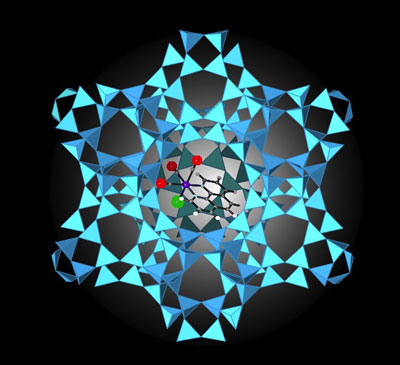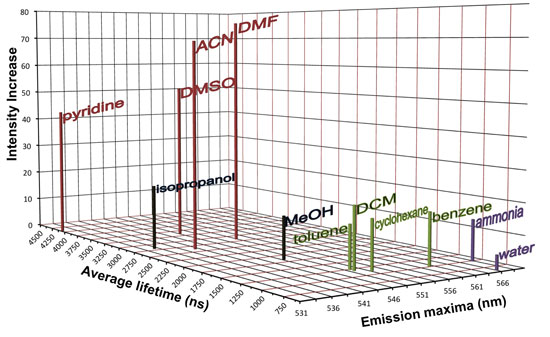| Oct 10, 2013 |
'Ship in a bottle' detects dangerous vapors
|
|
(Nanowerk News) Rice University scientists took a lesson from craftsmen of old to assemble microscopic compounds that warn of the presence of dangerous fumes from solvents.
|
|
The researchers combined a common mineral, zeolite, with a metallic compound based on rhenium to make an "artificial nose" that can sniff out solvent gases. They found that in the presence of the compound, each gas had a photoluminescent "fingerprint" with a specific intensity, lifetime and color.
|
|
Rice chemist Angel Martí and his students reported their results this month in the journal Angewandte Chemie ("Three-Dimensional Solvent-Vapor Map Generated by Supramolecular Metal-Complex Entrapment").
|
 |
| A rhenium-based complex trapped inside zeolite is able to warn of the presence of dangerous fumes from solvents. The Rice University researchers used a "ship-in-a-bottle" type of chemical assembly to create the promising material. (Credit: Angel Martí/Rice University)
|
|
The challenge for Martí and his team was to get their large metallic particles through the much smaller pores of a zeolite cage. The answer: Do it old-school. In their process, small chemical components enter the cage, find each other and self-assemble into rhenium complexes. Then they're stuck -- like a ship in a bottle.
|
|
"We sequentially load the individual parts of the complex into the zeolite," Martí said. "The parts are smaller than the pores, but when they self-assemble inside the zeolite, they're trapped." Once washed to eliminate complexes that form outside the zeolites, the compound is ready for use.
|
|
The relatively simple technique, which was initially developed and studied by two Rice alumni while they were undergraduate students in Martí's lab, could provide a scalable, inexpensive platform to monitor toxic vapors from industrial solvents.
|
|
Solvents are liquid chemicals, often petroleum-based, that are widely used to dissolve solid materials. They are found in paints, thinners, aerosol sprays, dyes, marking pens, adhesives and many other products.
|
|
They also evaporate quickly. Solvent vapors, which are hazardous to inhale and can be highly flammable, are often denser than air and gather at floor level, where they can build to dangerous amounts unless detected.
|
|
Martí said platinum, gold, palladium and copper salts are often used to detect vapors, because they change color in the presence of solvents. The rhenium-based supramolecular complex was known to fluoresce in the presence of some solvents, but dealing with vapors is a different story.
|
|
"If the complexes are in a solid state, they are too close to each other and gases can't interact with them," he said. "So we started thinking of ways to create space between them."
|
|
Enter zeolites. "These zeolites are cages with big cavities and small pores," Martí said. "The pores are big enough -- at about 7.4 angstroms -- for most gas-phase molecules to enter. The question was how to trap the bigger rhenium complexes inside."
|
 |
| Rice University researchers have created a chemical sensor to identify solvent fumes by their fluorescent "fingerprints." Three unique characteristics for each type of vapor -- the average lifetime, intensity increase and emission maxima -- allowed the researchers to plot them on a 3-D map. (Credit: Angel Martí/Rice University)
|
|
Other groups have trapped ruthenium complexes in zeolites, but these complexes were not ideal to detect solvents. Then-undergraduates Ty Hanna and, later, Zack Panos developed the method to put rhenium complexes inside zeolites. The results were outstanding, Martí said.
|
|
Like canaries in a coalmine, the caged complexes strongly signal the presence of a vapor by the color and intensity of their photoluminescent glow in ultraviolet light.
|
|
Martí said nobody had studied the third key property -- the amount of time the complex remains in an excited state. That ranges from less than 1,000 nanoseconds for water and ammonia to "a quite long" 4,000-plus nanoseconds for pyridine. It's different for every type of vapor, he said.
|
|
"We concluded that every individual vapor has a set of photophysical properties that is unique for that solvent," he said. "Each one has a unique fingerprint."
|
|
With the ability to detect three distinct characteristics for each vapor, a team led by graduate student Avishek Saha built a three-dimensional plot to map the fingerprints of 17 types of solvents. They found categories of solvents -- nonpolar, alcohols, protics (which include water) and aprotics -- tended to gather in their own areas.
|
|
"That's another interesting thing," Martí said. "Different solvent groups occupy different areas in the map. So even if a solvent hasn't been studied, our material will help people recognize the category it falls into."
|
|
He said the group plans to test more solvents and suggested the material may also be useful for detecting the presence of other volatile species like explosives.
|


